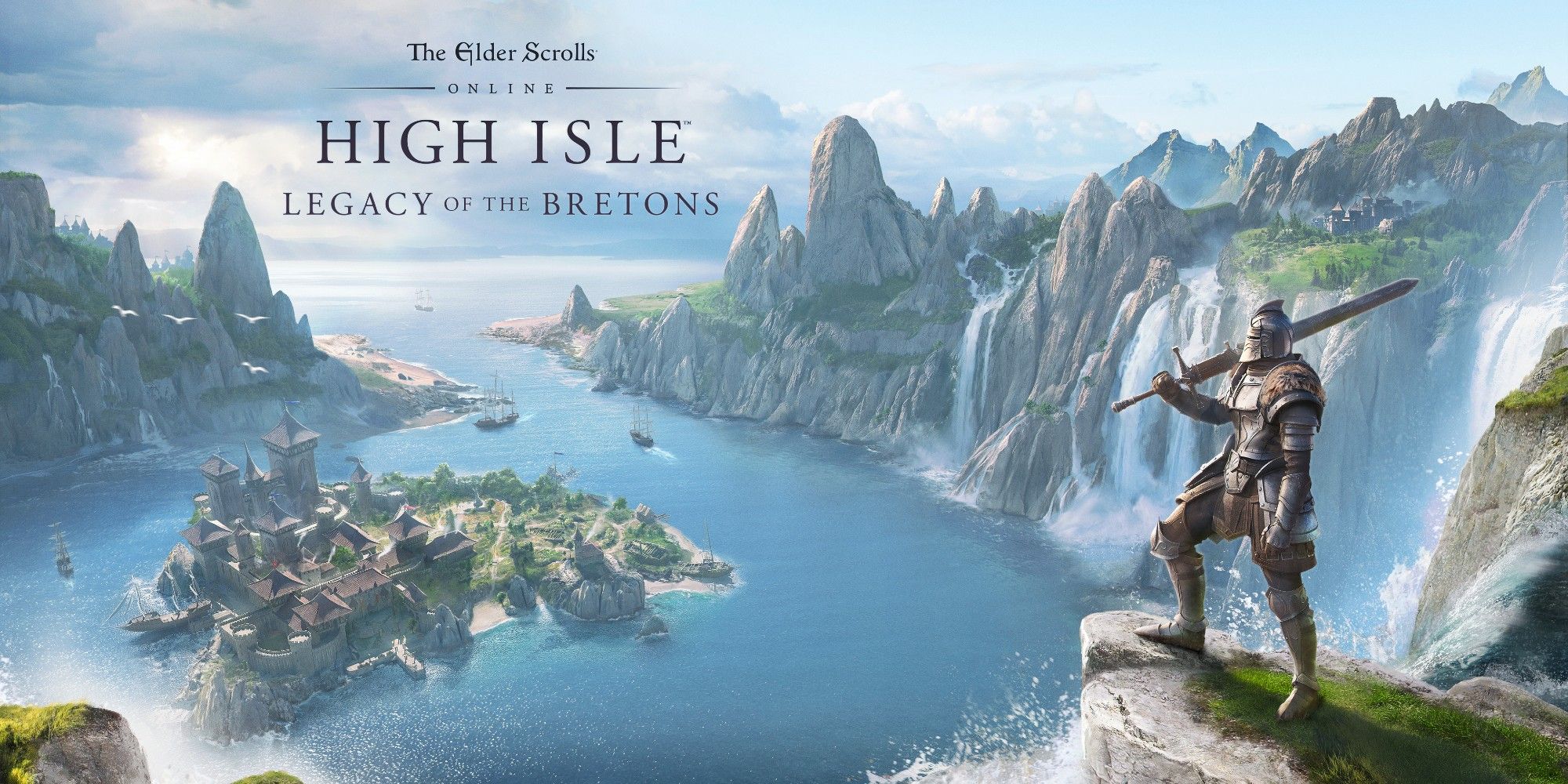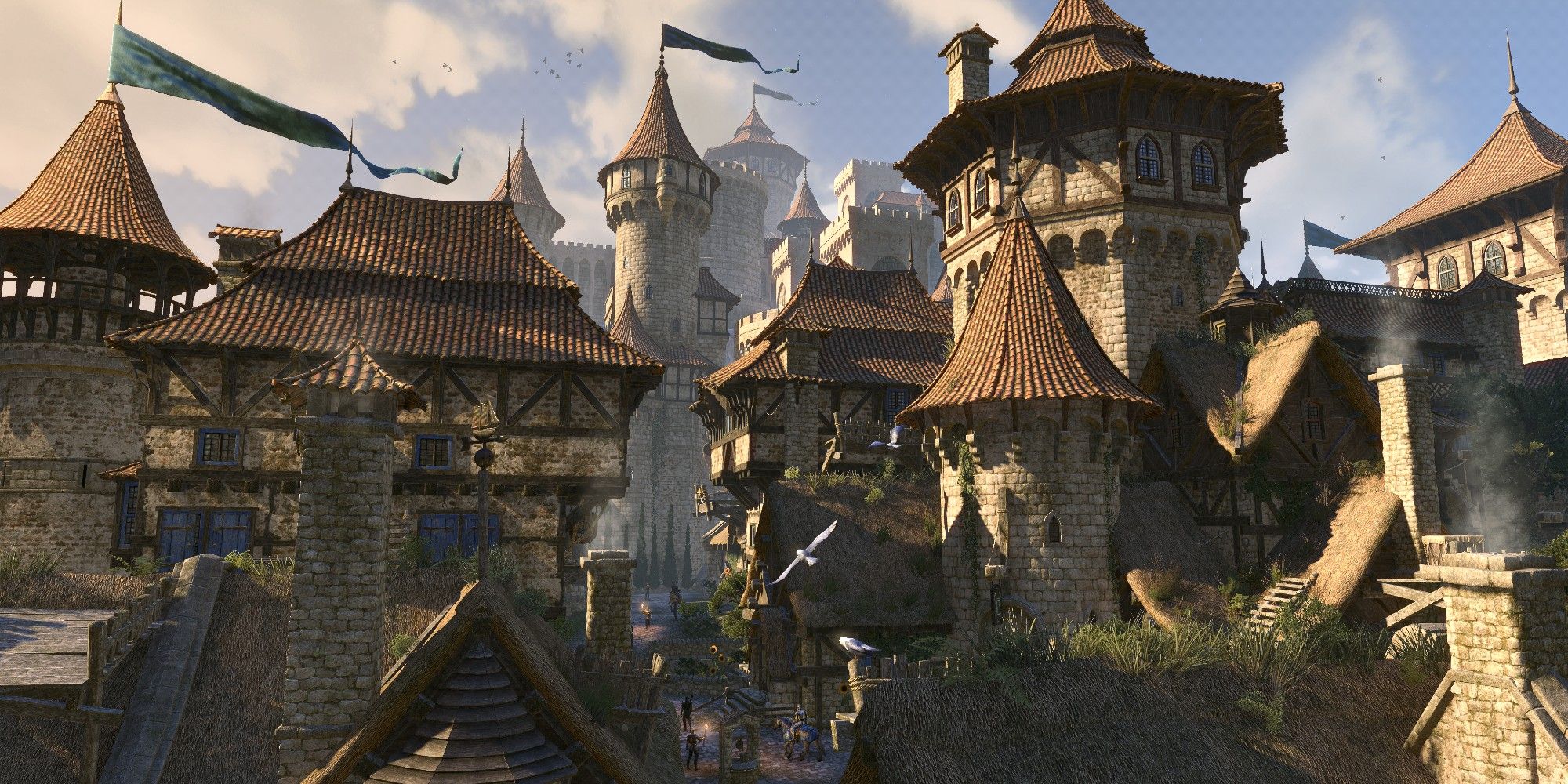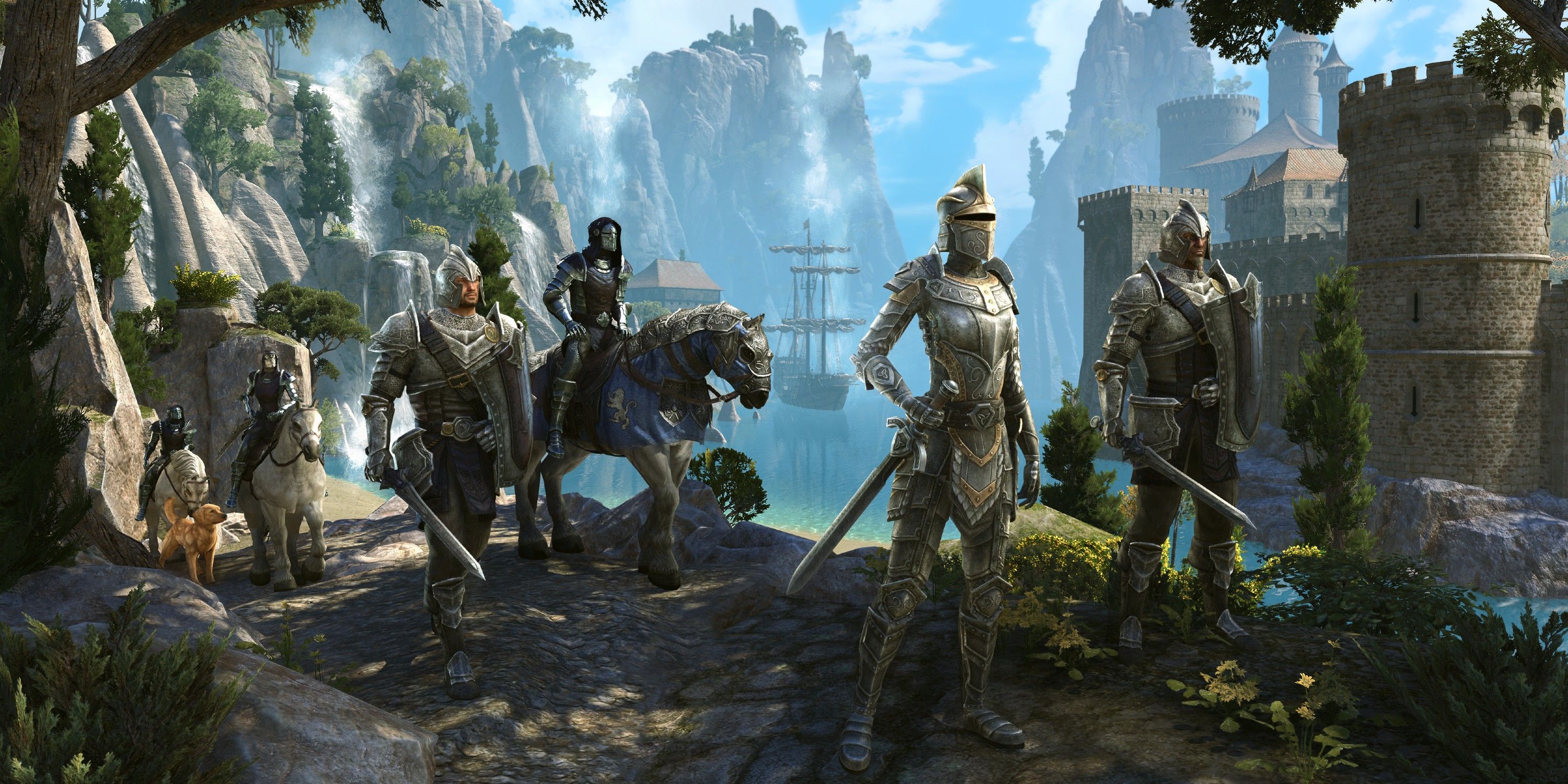
The next year of content updates for Elder Scrolls Online promise to take players to a part of Tamriel never before seen in an Elder Scrolls game: the Systres Archipelago in High Isle to explore the legacy of the Bretons. Every year, Elder Scrolls Online fans can look forward to four major content updates around a specific theme. Where 2021 took players to Blackwood and the Deadlands to explore the events preceding The Elder Scrolls IV: Oblivion, 2022 will focus on the Breton race and the political intrigue The Elder Scrolls is known for. Players can expect a new land to explore, new Elder Scrolls Online companions to aid them on their journey, and a mysterious plot to uncover.
In Elder Scrolls Online, High Isle is a sort of resort for some of Tamriel's wealthiest denizens. It is also the home of the Bretons, an Elder Scrolls race descended from both humans and elves. The idyllic Systres Archipelago has been selected as the location for peace talks to bring an end to the Three Banners War, hosted by the Society of the Steadfast. However, given High Isle's reputation for ruthlessness, players will need to tread carefully as they begin their adventure.
Elder Scrolls Online's Systres Archipelago is a rich and unique environment that takes inspiration from the Mediterranean and Medieval England. As with any new chapter of Elder Scrolls Online, the environment helps tell the story and immerse players in the world of Tamriel. CJ Grebb, Art Director for Elder Scrolls Online, recently sat down with Screen Rant to talk about how the team created these new landscapes to fit the year-long, Breton-themed story of High Isle.

Political intrigue is at the heart of most Elder Scrolls games, but it hasn't been the main focus for several expansions. What inspired the team to return to these roots?
CJ Grebb: We had done big, existential crises and world-ending scenarios for a couple of major pieces of content. I know those adventures are obviously fun, and it's awesome to do that. [Now,] They're about getting back to some of the roots of Elder Scrolls and really digging deep into political intrigue and backstabbing, and the conversations that happen behind closed doors with people in power.
[We] combine that desire to tell a more intimate story with the idea of going and really giving the Bretons their due, as far as getting into their culture and writing some more lore for them and investigating this really intriguing culture in Tamriel. Combine those two ideas, and you really have a perfect scenario for an intriguing, smaller, but still important storyline.
It's about finding out who's behind the scenes and who's pulling the strings when it comes to trying to promote or stop the alliance - I'm getting into the weeds here. The story largely lies around the Three Banners War and the idea that negotiations might be possible to start to bring it to some sort of culmination.
The Systres, the island chain that the Bretons are on, is an ideal place to have such a such a meeting and to begin such talks, because the Systres has been sort of neutral. They've been largely concerned with their economic livelihood, and that means being able to reach out to all of Tamriel to keep those channels open. That has given them a certain neutrality, but it's still a Breton island. Being a Breton island means that there are nobles, and there are people who are vying for power at all times - economic and political. And some of them might not be so excited to hear that there are talks going on between the alliances that might not align with everyone's interests on that island.
That leads into the story and into the idea of figuring out who's on what side, and where are those secret meetings with lots of interruptive chatter about the talks happening. And who's really behind it? In a stratified society where everybody's backstabbing each other already, figuring out who's pulling the strings is very difficult.
What was the inspiration for the Breton culture, and how did the art team go about conceptualizing and designing this new location?
CJ Grebb: The Breton's have a really interesting history. They started out half-man and half-elf - their ancestry is anyway. The bloodline is mixed between elves and men. In the First Era, that manifested by actually being subjugated by the elves.
The elves had come into High Rock, they had taken over the lands, and they subjugated the tribes of men that were there. In that, there was some interbreeding which produced the Breton race, and the Bretons entered into existence in this highly stratified caste-like society that the elves run. Eventually, over the centuries, they just outlasted the elves. There were so many Bretons that they were able to take over those lands.
What's interesting, though, is that despite the fact that they overthrew the elves more or less, they still maintained lots of aspects of that stratified society. They still kept the ideas of haves and have nots and nobles and peasants and stuff like that. But it's in the lens of a people who overthrew their oppressors at a certain point. There's always that aspect of their culture that's about the lower classes having a chance to achieve; to get over the hump and into the upper classes. That's a belief and a philosophy that runs deep in their blood.
That history runs really deep into everything that happens in their Second Era. It's that underpinning belief in their ability to achieve that walks its way through the entire adventure, and it's not only the comings and goings of the nobles, but it's the way that all of that affects all of the Breton society. It's an interesting basis for our culture, and it really makes its way into pretty much everything that you see when you're walking around the High Isle.

There's a combination of an English medieval style and an almost Mediterranean landscape. Could you talk a little bit about designing that and putting those two concepts together?
CJ Grebb: The idea of it being based upon the Mediterranean started with the writers and the initial pitch that they threw at us for. They give us a rough idea, like, "Here's where we're going, here's the round corners of the story. We think it would be fun to do this in a Mediterranean paradise." What would the Bretons do if they got their hands on a beautiful Mediterranean-ish island?
That sets the concept artists off in a direction. They can do some research on the limestone cliffs and the beautiful, sweeping hills of the Mediterranean environments and biomes here on Earth. To fold that into the Breton culture, we looked at the architecture and the furniture from the base game, that was obviously going to be our starting point. But we also wanted to make it a bit different; we wanted to account for the fact that they'd be using different materials from the land and from the island itself. With these lighter stones, would the construction need to be different?
So, we folded in some medieval Germanic influences from our world into this, and we kind of combined the base game Breton architecture ideas with that Germanic medieval idea. We came up with a more refined Breton look to the buildings: a bit more storybook, a bit more of a resort or "Castles of Camelot" kind of look. It's premium, as would be expected of a high-going society, but it's still centered in that idea that the Bretons don't go into pomp and circumstance as much as the elves do.
We're in an island that's just north of Summerset. They're going to share some geographical aspects, some flora and fauna might be the same, but the Britons don't go in for the high Gothic excess that the elves do. So, although it's beautiful and it's storybook, it's still sort of grounded and still very Breton in the way that it comes out in the end.
Since it's a chain of islands, you mentioned that there's another island, the jungle prison of Aminos. What were the inspirations for designing that specific area?
CJ Grebb: The immediate shorthand for Aminos was kind of "escape from New York." It's the idea that the Bretons are on this beautiful island. They've built up a very high-going society there. But it is still the Bretons. There's going to be intrigues, there's going to be dissidents, there's going to be backstabbing and arrests. And what do you do with the people who are trying to disrupt this beautiful land that you've got? "Well, we've got this super dangerous jungle island just to the north of us. Why don't we just throw everyone we don't want to be a part of the main island up there and let them fend for themselves?"
The story gets really interesting in that you've got a bunch of Bretons who have a history of breaking out of subjugation. Now, they have subjugated a great deal of people on this island. What would that do to not only the politics of the main island, but what would the new politics be of the Bretons who are on this jungle prison? They're still Bretons too, so they would stratify. They would come up with fiefdoms, and they would gang together for their own protection.
It's an interesting dichotomy between the two islands: between the haves and the have nots. And then, inside this island of have nots, they're going to have their own society of haves and have nots. Intrigues, people who are trying to get off the island, and people who are trying to facilitate people getting off the island, and people who are perfectly content to stay on the island to be the facilitator of people trying to get off the island. All of that stuff is wrapped up in the story, so it's all there for the picking from a storytelling stand.
Are there any special gameplay elements that players can expect in this area?
CJ Grebb: It's more or less the standard adventure you would have. There always going to be some aspects of new zones that are unique, and mechanics and stuff. But that's really not my area to talk about, so I don't want to want to get too deep into that and say something that wouldn't be true.

Could you say anything else about the other biomes in the archipelago that players may encounter as they're adventuring?
CJ Grebb: I can tell you that there's a faction on the main island - and it's a faction of Bretons - that are not as interested in the way that the main movers and shakers in Breton society have aligned themselves with all of this nonsense going on in Tamriel. With the entry into the Three Banners War and the interaction with so many different cultures, they feel that Bretons have gotten away from their roots, so to speak.
You get a tantalizing tease of this faction of Bretons in the story in High Isle that gets expanded on a little more in the adventures to come. I kind of want to leave it there - I don't want to get into spoilers - but it was one of the more interesting aspects for the art team to think about and noodle on and know that more is coming.
As far as the new gear, since the new armory system came out and gear is very big with fans of ESO, what was it like designing that specific aspect of this expansion?
CJ Grebb: It was a lot of fun, because we knew we wanted to do something [new]. The Bretons have a very - I don't want to use words like cliché, but they really are of all the Tamriel races the ones that feel most like the classic Medieval knights in shining armor. They have banners and taverns and tournaments, and that classic King Arthur vibe is very much in line with what we do with the Bretons.
To give them this fantastic and beautiful paradise island, we got to really get deep into those shapes and into those classic Medieval plate armors and heraldry, and all the colors that come along with that. It was a refreshing bit of design that we got to sort of dive into.
Out of curiosity, what is your favorite part about what's coming in this year-long set of updates and new content?
CJ Grebb: I mentioned this new faction of Bretons that we're going to meet on the island, and their story is really intriguing and really mysterious.
In addition to trying to figure out the political intrigues of the established Bretons, you also get to dive into these more reclusive, but certainly more traditional, aspects of Breton culture. You understand that there's a lot of different ways to engage with the history of the Bretons, and this particular faction is taking a very traditional and a very naturalistic bent to it. It's been really fun exploring that.
Elder Scrolls Online is available on PlayStation 4, PlayStation 5, Xbox One, Xbox Series X/S, and PC.
Comments
Post a Comment